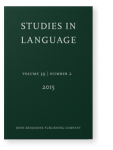Vol. 39:2 (2015) ► pp.257–321
Pronominal datives
The royal road to argument status
Based on a large corpus of dative constructions in Hebrew, we propose that dative-marked pronominals manifest a facilitated path from adjunct to argument. Since datives tend to be pronominal, adding them onto existing argument structures avoids a clash with the Preferred Argument Structure (PAS) Quantity constraint against more than one lexical noun phrase per clause. Supporting a more fluid adjunct/argument distinction, our first claim is that different Hebrew datives are grammaticized as arguments to different degrees. We then demonstrate a correlation between the degree of grammaticization of the dative as an argument and pronoun/lexical ratios. We show that incipient grammaticization phases involve virtually exclusive use of pronominal datives, but deeper grammaticization phases allow increased use of lexical nouns, within the constraints of PAS. Thus, it is pronouns that blaze the path from adjunct to argument status.
Cited by (8)
Cited by 8 other publications
This list is based on CrossRef data as of 19 july 2024. Please note that it may not be complete. Sources presented here have been supplied by the respective publishers. Any errors therein should be reported to them.
